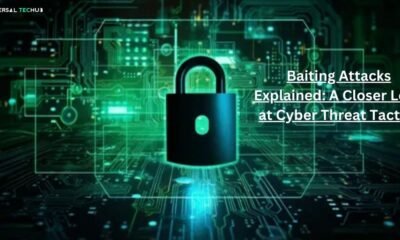Tech News
FTAsiaEconomy Technology Updates: Driving Regional Growth

Introduction
A. Overview of the FTAsia Economy and Its Dynamic Nature:
To me, Asia is a vibrant tapestry of cultures and economies, each with its unique strengths and challenges. It’s not just about the sheer size of the market, but the incredible speed at which things change. I’ve witnessed firsthand the transformation of cities that were once primarily agricultural into bustling tech hubs. The entrepreneurial spirit here is infectious. Countries like China, Japan, South Korea, India, and Singapore aren’t just participants in the global economy; they’re setting the pace. The dynamic markets, the intricate supply chains, and the rapid adoption of digital technologies create a sense of constant evolution. I’ve always been fascinated by how quickly new ideas and innovations take root here, especially considering the impact of ftasiaeconomy technology updates.
B. Defining “Technology Updates” in the Context of Regional Economic Development:
When we talk about “technology updates,” we’re not just talking about the latest smartphones or software releases. We’re talking about the fundamental shifts in how we live and work. It’s the deployment of 5G networks that enable real-time communication and data processing. It’s the rise of AI that’s automating tasks and creating new possibilities. It’s the advancements in robotics that are transforming manufacturing. It’s the fintech revolution that’s democratizing access to financial services. It’s the push for green technologies that’s addressing climate change. And it’s the ongoing battle against cyber threats that’s protecting our digital infrastructure. These updates, as tracked by ftasiaeconomy technology updates, are reshaping industries, creating new jobs, and transforming the way we interact with the world. I believe it’s important to view these updates as tools that can if used correctly, improve the lives of millions.
C. Thesis Statement:
From my perspective, it’s undeniable that technology updates are the primary drivers of economic transformation in the FT Asia region. They’re not just a contributing factor; they’re the catalyst. They’re reshaping digital infrastructure, revolutionizing commerce, transforming traditional industries, and forcing policymakers to adapt at an unprecedented pace. This transformation, largely driven by ftasiaeconomy technology updates, while full of immense potential, also presents significant challenges that require careful consideration and proactive solutions. I believe that understanding these challenges and opportunities is key to navigating the future of the FT Asia economy.
D. Scope of the Analysis:
In this analysis, I want to delve deeper into the intricate relationship between technology updates and economic growth. I want to explore not just the “what” of these advancements, but also the “how” and the “why.” How are these updates, specifically ftasiaeconomy technology updates, actually driving regional growth? What are the real-world implications for businesses and individuals? And what are the ethical and social considerations that we need to address? I aim to provide a comprehensive overview of the impact of technology updates on the FT Asia economy, with a focus on the trends highlighted by ftasiaeconomy technology updates.
Digital Infrastructure: FT Asia Economy Technology Updates Drive Regional Growth
A. Expanding Broadband and 5G Networks:
I’ve seen firsthand how the rollout of 5G is transforming cities and industries. It’s not just about faster download speeds; it’s about enabling a whole new ecosystem of applications and services. Think about the potential for remote healthcare, smart transportation, and immersive virtual reality experiences. Countries like China and South Korea are leading the way in 5G deployment, and it’s fascinating to witness the ripple effect across various sectors, as documented by ftasiaeconomy technology updates.
B. Cloud Computing and Data Centers:
The shift to cloud computing has been a game-changer for businesses of all sizes. It’s allowed them to scale their operations, reduce costs, and access powerful computing resources on demand. The data centers popping up across Asia—in places like Singapore, India, and Hong Kong—are becoming crucial hubs for the global digital economy. I find it intriguing how these data centers are becoming the backbone of our digital lives, storing and processing vast amounts of data that power everything from social media to e-commerce, a trend that is consistently visible in ftasiaeconomy technology updates.
C. Smart City Initiatives:
Walking through a smart city feels like stepping into a science fiction movie. Singapore’s Smart Nation initiative, for example, is a testament to what’s possible when technology is integrated into urban planning. The way IoT sensors, AI algorithms, and data analytics are being used to optimize everything from traffic flow to energy consumption is truly remarkable. These initiatives are not just about improving efficiency; they’re also about enhancing the quality of life for citizens, and these advancements are well covered by ftasiaeconomy technology updates.
D. Economic Indicators and Productivity Growth:
It’s not just anecdotal evidence; the data clearly shows that investments in digital infrastructure are directly correlated with GDP growth and productivity gains. When you improve connectivity and efficiency, you unlock new opportunities for businesses and individuals. You reduce friction in the economy and enable new business models. I’ve seen how these investments can transform entire communities, creating jobs and driving economic development, all of which reflect the core of ftasiaeconomy technology updates.
The Role of Technology Updates in Economic Growth
A. Technology as a Catalyst for Innovation and Productivity:
To me, technology is the ultimate disruptor. It challenges the status quo and forces us to rethink how we do things. AI-powered automation, for instance, is not just about replacing jobs; it’s about augmenting human capabilities and freeing up our time to focus on more creative and strategic tasks. I believe that technology, especially as observed within ftasiaeconomy technology updates, has the potential to unlock human potential and drive innovation across all sectors.
B. Economic Diversification and Resilience:
The ability to diversify is crucial in today’s interconnected and volatile world. By embracing technology, countries can reduce their reliance on traditional industries and build more resilient economies. South Korea’s transition from a manufacturing-based economy to a technology-driven economy is a perfect example of how diversification, fueled by trends like those detailed in ftasiaeconomy technology updates, can lead to long-term economic success.
C. Human Capital Development:
One of the biggest challenges we face is ensuring that our workforce has the skills needed to thrive in the digital age. This means investing in digital literacy and STEM education and creating opportunities for lifelong learning. I believe that education is the key to unlocking the full potential of technology and ensuring that everyone benefits from its advancements.
Key Technology Updates in FT Asia Economy
A. Digital Technology Innovations:
The pace of innovation in digital technology is simply breathtaking. From blockchain to cybersecurity, we’re seeing advancements that are transforming every aspect of our lives. Blockchain technology, for example, has the potential to revolutionize supply chains and financial transactions. And advancements in cybersecurity, as vital components of ftasiaeconomy technology updates, are crucial for protecting our digital infrastructure and data.
B. Artificial Intelligence and Robotics:
I believe that AI and robotics have the potential to solve some of the world’s most pressing problems, from healthcare to climate change. But we also need to be mindful of the ethical implications and ensure that these technologies are used responsibly. The usage of AI in medical diagnostics, and the creation of robotics that can perform dangerous tasks are only two examples of the positive impact that these technologies can have.
C. Green and Sustainable Technologies:
The push for sustainability is not just a trend; it’s a necessity. I’m encouraged to see so many countries in Asia leading the way in renewable energy, smart grids, and electric vehicles. The innovations in solar panel technology and the advances in battery storage are very promising.
The Rise of Digital Commerce
A. Mobile-First Economy:
In Asia, the mobile phone is far more than just a communication tool; it’s a gateway to a vast digital ecosystem. I’ve been amazed by the sheer ubiquity of mobile payments and e-commerce. From street vendors accepting digital wallets to the seamless integration of online shopping into daily life, the mobile-first approach has transformed consumer behavior. E-commerce giants like Alibaba and Shopee have built massive platforms that cater to this mobile-centric market, creating a truly interconnected digital economy. The rise of super-apps that integrate various services into a single platform is a testament to the mobile-first mindset.
B. Cross-Border Trade Integration:
Digital platforms are breaking down traditional trade barriers, enabling small and medium-sized enterprises (SMEs) to access global markets. This is a game-changer for economic inclusion, allowing businesses to expand their reach beyond their local communities. ASEAN’s digital trade agreements, for example, are fostering greater connectivity and economic integration across the region. I see this as a powerful force for democratization, leveling the playing field for businesses of all sizes. The improvements to online logistics and supply chain tracking have also been very important to this expansion.
C. Data-Driven Marketing and Customer Personalization:
The ability to personalize customer experiences is becoming increasingly crucial in today’s competitive market. Companies are leveraging AI and big data to analyze consumer behavior, anticipate needs, and tailor their offerings. This level of personalization, while powerful, also raises important questions about data privacy and ethical marketing practices. I’ve observed the impact of targeted advertising and personalized recommendations, and it’s clear that data-driven marketing is a key driver of growth in the digital age.
Innovation Ecosystems and Startups
A. Research and Development:
Investment in R&D is the lifeblood of innovation. I’m inspired by the collaborative efforts between governments, corporations, and universities to drive technological advancements. The establishment of research parks and innovation hubs is fostering a culture of experimentation and discovery. I believe that these investments are crucial for ensuring the long-term competitiveness of the FT Asia economy. The amount of international collaboration that is now happening is also very promising and is well represented in the analysis provided by ftasiaeconomy technology updates.
B. Startup Landscape:
Asia’s startup ecosystem is thriving, with venture capital funding fueling innovation across a wide range of sectors. From fintech to biotech, startups are pushing the boundaries of what’s possible. I’ve been particularly impressed by the creativity and resilience of entrepreneurs in the region. The role of incubators and accelerators in providing mentorship and resources is also vital for the growth of the startup ecosystem.
C. Technology Transfer and Knowledge Sharing:
International collaboration is essential for accelerating tech adoption and knowledge sharing. Platforms for exchanging best practices and research findings are crucial for fostering innovation. I see this as a way to bridge the gap between developed and developing economies, allowing everyone to benefit from technological advancements. The flow of talent between countries is also an important aspect of this.
Impact on Traditional Industries
A. Manufacturing and Industry 4.0:
Smart factories and IoT-driven automation are transforming the manufacturing sector, increasing efficiency and reducing costs. The adoption of Industry 4.0 technologies is enabling manufacturers to optimize their supply chains and respond to changing market demands. I’ve witnessed the transformation of factories into highly automated facilities, and it’s clear that this trend is reshaping the future of manufacturing.
B. Financial Services and Fintech:
Fintech innovations are revolutionizing the financial services industry, making it more accessible and efficient. Mobile banking, digital payments, and blockchain technology are disrupting traditional banking models. I’m excited by the potential of fintech to democratize access to financial services, particularly for underserved populations. The AI driven credit assessments, and fraud detection are also very important aspects.
C. Agriculture and Tourism:
Technology is also transforming traditional industries like agriculture and tourism, improving productivity and enhancing customer experiences. Precision agriculture, for example, is using data analytics and IoT sensors to optimize crop yields. And technology-driven tourism platforms are providing personalized travel experiences. I’ve seen how technology is helping farmers optimize their resources and how virtual reality is enhancing the tourism experience.
Challenges and Opportunities
A. Digital Divide:
Bridging the digital divide is a critical challenge. We need to ensure that everyone has access to technology and the skills needed to use it effectively. Governments and businesses must work together to invest in digital infrastructure and education. I believe that digital inclusion is a fundamental human right.
B. Cybersecurity:
As our reliance on digital technologies increases, so does our vulnerability to cyber threats. We need to invest in robust cybersecurity frameworks and promote a culture of cybersecurity awareness. I’m concerned about the growing sophistication of cyberattacks and the need for greater international cooperation in combating cybercrime.
C. Regulatory and Policy Challenges:
Governments need to strike a balance between fostering innovation and protecting consumers. Regulatory frameworks must be adaptable and forward-looking to keep pace with rapid technological change. I believe that open dialogue between policymakers, industry leaders, and civil society is essential for developing effective regulations.
Future Outlook
A. Emerging Technologies:
Quantum computing, the metaverse, and nanotechnology are just a few of the emerging technologies that will shape our future. I’m excited by the potential of these technologies to solve some of the world’s most pressing problems.
B. Policy Development:
Proactive policies are needed to support technological adoption and address ethical concerns. International collaboration is crucial for developing global standards and best practices.
C. Economic Trends:
Technology will continue to drive economic trends, creating new opportunities and challenges. We need to be prepared for the disruptions and transformations that lie ahead.
Conclusion
Technology updates are undeniably the engine of economic growth in the FT Asia region, as continually documented by ftasiaeconomy technology updates. While challenges remain, the future is bright for those who embrace innovation and adapt to change. I believe that by working together, we can harness the power of technology to create a more prosperous and equitable future for all.

-

 Phishing attack8 months ago
Phishing attack8 months agoWhat is Spear Phishing and How You Can Identify This Scam?
-

 Social engineering attack9 months ago
Social engineering attack9 months agoBaiting Attacks Explained: A Closer Look at Cyber Threat Tactics
-

 Social engineering attack7 months ago
Social engineering attack7 months agoWhat are Social Engineering Attacks – A Complete Guide to Cyberattacks Prevention
-

 Social engineering attack9 months ago
Social engineering attack9 months agoSpear Phishing Attack: A Targeted Cyber Threat
-

 Social engineering attack9 months ago
Social engineering attack9 months agoWhat is spear phishing attack? A detailed guide
-

 Social engineering attack9 months ago
Social engineering attack9 months agoWhat is spear phishing in cyber security?
-

 Phishing attack7 months ago
Phishing attack7 months agoWhat Are Phishing Emails? A guide for you
-

 Phishing attack3 months ago
Phishing attack3 months agoWhy is Phishing Still a Major Cyber Threat? Everything You Need to Know



















